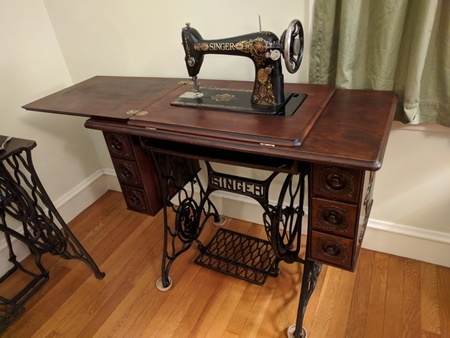
Tri-needle – as its name suggests, this type of needle is used for sewing triple decorative stitches. The first number represents the gap between the two needles measured in millimeters while the second number represents the needle size. Because of that, it is used for sewing double decorative stitches. Twin needle – this type of needle actually consists of two needles joined together on a single carrier. Serv7 needle – a scarf shaped needle with a sharpened blade used for dealing with difficult to cut materials. This minute point not only cuts the fabric but moves it sideways as well. SD1 needle – similar to DI needle, however with a smaller cutting point. Consequently, the blade’s diamond shape allows the needle to cut the fiber, instead of ripping it. DI leather needle – this is the type of needle that is specialized for dry, heavy and hardened leather. Ballpoint needle – used for elastic materials because its design allows the needle to pass through the fiber, not over it, thus preserving the fabric’s elasticity.

Round point needle: this is the most widely spread type because it is used in almost every kind of sewing activity there is. This is, of course, because the point of a universal needle is both sharp and rounded, allowing the needle to have the characteristics of sharp and ballpoint needles alike. Obviously, we can use universal needles for both types of fabric. Knit fabric needs the point to glide between the loops damaging neither the fibers nor the fabric and that is when we use ballpoint needles. We use the sharp point when sewing straight lines. However, note that different fabric types require different types of needle points. There are three common types of needle points – universal, sharp and ballpoint. Point – Sharpe top of the needle and the first element that touches the fabric. Scarf – The curved slot located above the eye that closes the setting between the looper and the needle. In short, its purpose is to hold the thread. The eye of the needle – the opening at the needle’s top.


It creates the loop together with the sewing thread. Short groove – the part between the tip and the eye of the needle. Long groove – r educes friction between the needle, fabric and the sewing thread. Of course, t his is the point of maximum friction between the needle and the fabric. It reduces friction between the needle and the fabric. Shoulder – a part that follows the shank. There are two kinds of shanks - flat and cylindrical. It is located under the butt and is tied to the needle bar. Shank – the basis and the widest part of the needle. It’s used to attach the needle to the sewing machine.


 0 kommentar(er)
0 kommentar(er)
